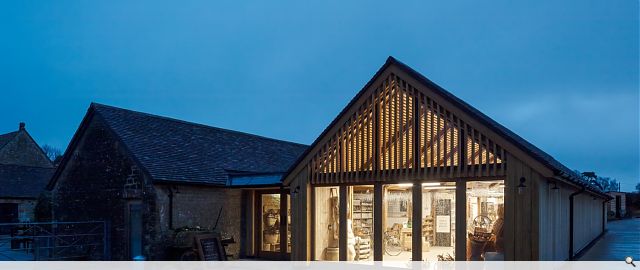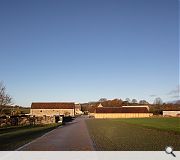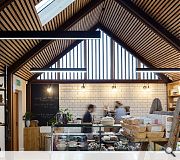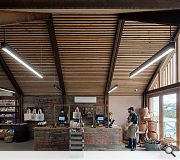Durslade Farm Shop
Since opening in 2014 Hauser & Wirth’s art centre in Bruton, Somerset (UK) has become a significant cultural institution creating numerous jobs and drawing hundreds of thousands of people to the area. The farm shop is the latest addition to a site that has evolved organically over the centuries. Consolidating and expanding the existing estate shop in a more welcoming and accessible location, it offers a better platform for the promotion of local farmers and makers to sell their wares, supplements the on-site Roth Bar & Grill and provides opportunity for visitors to purchase high quality ingredients and local seasonal produce. In addition, the new extension will also increase back of house support facilities and include more relaxed dining options for visitors.
Taking cues from the surrounding vernacular forms, the modest extension is a contemporary interpretation of a traditional agricultural building. The new volume is a simple and efficient extrusion, pulled away from the adjacent building, with a smaller linking element between that serves as the main entrance to the shop. Materials were chosen to complement the surrounding buildings, and the substantial use of timber and recycled components, is both sustainable and economical. Rough sawn vertical timber cladding will weather over time, setting the building into its rich historic context.
The new building is characterised by its gable roof clad in reclaimed terracotta tiles, and will serve as its primary feature when viewed from the approach track and distant fields, again downplaying the extension as a modest component within a much larger whole. With sustainability underpinning all of Moxon’s work, and a core commitment of Hauser & Wirth’s, the new building serves as a showpiece to educate and promote sustainability to all visitors. The ability to sell local produce directly to consumers will further promote the ‘field to table’ philosophy currently practiced in all Hauser & Wirth hospitality establishments.
A high-performance envelope, passive ventilation, and natural daylighting all contribute to minimal energy demands and low impact materials such as timber and prefabricated panels were chosen for their lower embodied carbon footprint. Local resources and craftspeople were utilised throughout and salvaged materials such as the roof and display furnishings have been combined with robust, long-lasting finishes and details.
Back to Retail/Commercial/Industrial
- Buildings Archive 2024
- Buildings Archive 2023
- Buildings Archive 2022
- Buildings Archive 2021
- Buildings Archive 2020
- Buildings Archive 2019
- Buildings Archive 2018
- Buildings Archive 2017
- Buildings Archive 2016
- Buildings Archive 2015
- Buildings Archive 2014
- Buildings Archive 2013
- Buildings Archive 2012
- Buildings Archive 2011
- Buildings Archive 2010
- Buildings Archive 2009
- Buildings Archive 2008
- Buildings Archive 2007
- Buildings Archive 2006






